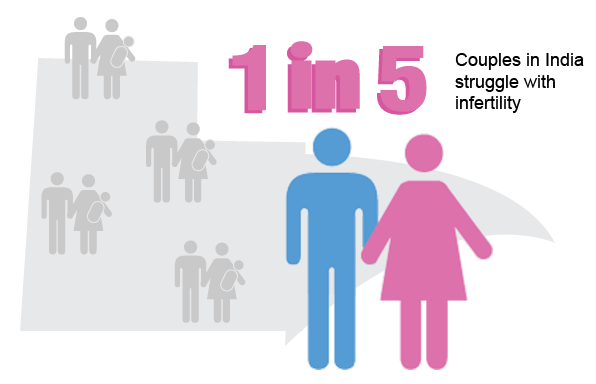
Infertility is not a disease but a disorder, wherein a couple fails to achieve pregnancy within 12 to 15 months of active married life, without using any contraceptives. It is observed that 15 - 18% of any population in the world, that is, almost one in every 5 couples, suffers infertility. (Female factor – 40%, Male factor – 40%, Male & Female factors – 10% and Unexplained Infertility – 10%).
The percentage of infertility is increasing due to change in life styles, food habits, fragile relationships, delayed marriages, stress-filled jobs, etc. apart from the huge accumulation of unresolved infertility cases over the years. The fertility graph starts descending as the women enter their 30s. Therefore, the fertility age is an important deciding factor and the proverb ‘Better late than never’ does not hold good in the matter of reproduction where ‘late’ means almost ‘never’. Obviously it is a matter of great concern and cannot be left unattended to any more.

There was a time when a small percentage of young couples remained childless throughout, branded as infertile and condemned as inauspicious in the society. It was widely believed that there could be no way out for these less-fortunate couples until 1978 when Professor Sir Robert Edwards and Dr. Patrick Steptoe brought joy to the infertile couples, with their incredible Assisted Reproductive Technique called ‘IVF’ (In vitro fertilization) followed by the birth of first ever IVF baby called Louise Brown in July 1978.
IVF came as a boon, but with its own limitations, such as affordability, low success rate, etc. We have little or no research on this subject in our country. We therefore, depend largely on the research done abroad for all our treatment guidance. All over the world the success rate of the advanced Assisted Reproductive Techniques (ART) is considered to be 35%. But the incidence of abortions of IVF pregnancies is higher in India as compared to that in abroad.
Unfortunately, even after three decades since the establishment of IVF as a legitimate treatment in reproductive medicine, it is not being utilized to the fullest extent mainly due to lack of adequate training in our country. Infertility and Assisted Reproductive Techniques (ART) is not included in the curriculum even at post graduate level in any medical college in India. Consequently, there exists a huge dearth of specialists in both Embryology and Clinical departments compared with the alarmingly high number of infertility cases in our country.
Bridging the skill gap through structured training programs is the need of the hour. MOMSOON started tailor-made skilling modules where trainees get maximum hands-on and adequate theory at reasonable cost and in reasonable time frame.
Enquiry